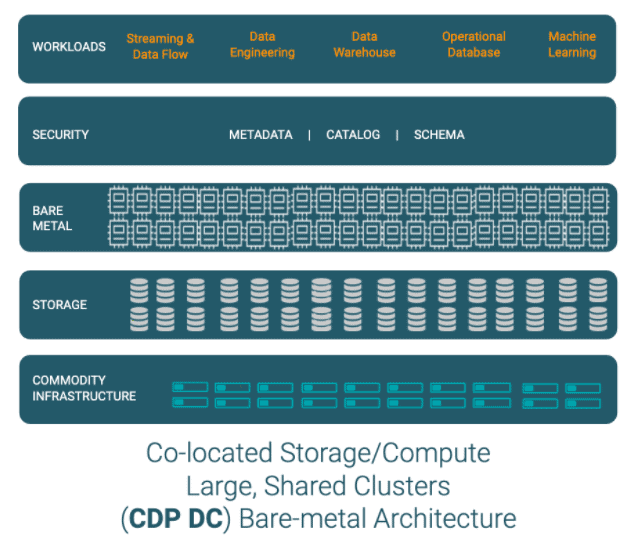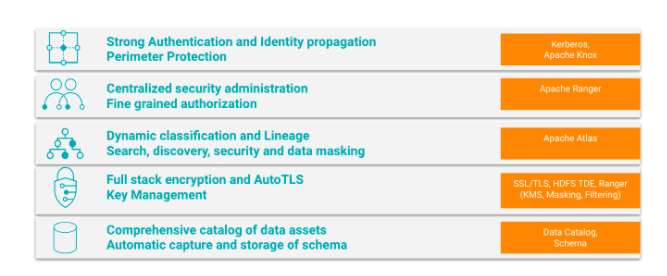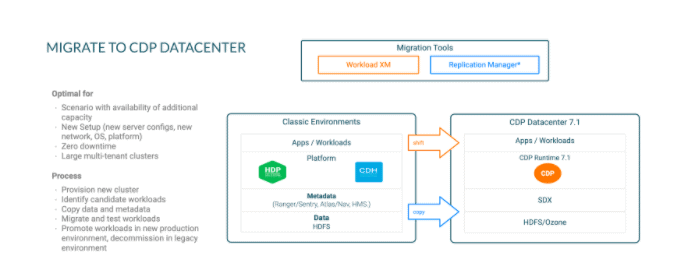Editor’s Note, August 2020: CDP Data Center is now called CDP Private Cloud Base. You can learn more about it here.
Cloudera Data Platform (CDP) Data Center(DC) is the on-premises release of Cloudera Data Platform. CDP DC combines the best services and components from Cloudera Enterprise Data Hub and Hortonworks Data Platform Enterprise along with new features and enhancements across the stack to deliver the premier on-premises enterprise data platform . This unified distribution is a scalable and customizable platform where you can securely run many types of workloads.

Organizations invest countless hours and resources in their on-premises big data platform. They create data pipelines to aggregate data and then run various workloads on that data to make decisions leveraging platforms like CDH and HDP.
Cloudera recently announced a new version of CDP Data Center, that allows customers to migrate or upgrade from their legacy CDH5 and HDP2.6 clusters and drive even more value from their data by gaining access to new features and functionality to enhance their big data experience.
The latest release brings in new capabilities and further enhancements that both CDH5 and HDP2 customers have been looking forward to for a while.
HPD2 customers can expect the following new functionality:
- Highly concurrent queries for OLAP with Impala
- Columnar data with Kudu to support real-time, predictive models
- Separation of compute and storage with new object store capabilities provided by Ozone, paving the way for transition to private cloud architectures
- Interactive ad-hoc SQL queries thanks to Hue
- Robust administration with Cloudera Manager allowing scalable cluster management
- Enterprise-class administration for streams messaging with support for monitoring and replication services
- Addition of encryption for data at rest and in motion, making it easier to meet compliance and audit requirements
CDH5 customers can expect the following improvements:
- Easy policy administration for all data services with Ranger, reducing management burden and enabling multi-tenant data access
- Faster data warehouse queries and updates with Hive 3, making offloading workloads from Teradata even more attractive
- Separation of compute and storage with new object store capabilities provided by Ozone and HDFS, paving the way for transition to private cloud architectures
- Enhanced data lineage with Atlas, improving traceability of data
- Enterprise-class administration for streams messaging with support for monitoring and replication services
- Addition of encryption for data at rest and in motion, making it easier to meet compliance and audit requirements
The new release helps customers utilize their data assets based on the following dimensions:
- Maximize Investment: By investing in CDP DC, the base for private cloud, customers are investing in their data lifecycle. The base edition provides the SDX data context layer with built-in authorization, governance and security principles that serve as the foundation of a robust analytics platform.

Customers can now continue to build on the applications and code that has been developed and tuned for years with the base edition, and create an optimized experience through features like workload isolation and compute storage disaggregation with the CDP Private Cloud.
- Improved Experience: The new release has built high-performance SQL analytics with Impala and Hive3. Integrated governance, security and unified policy management for Impala, Kudu and Hive with Ranger and Atlas. A comprehensive real time streaming experience includes stream processing, analytic and operations management.
- Unified Architecture: A unified architecture that allows seamless interaction between public and private cloud form-factors, using the same interfaces and constructs.

With all of these great benefits, customers can begin to migrate

or upgrade

to CDP Data Center, the base edition for CDP Private Cloud, from their CDH5 or HDP2 clusters and get the advantages of a unified platform.
For more detailed information, please refer to CDP Data Center Release Notes.
Additional resources to help:
- Getting Started with CDP Data Center
- CDP DC Installation and Upgrade Documentation
- CDP DC Trial Information and Download



